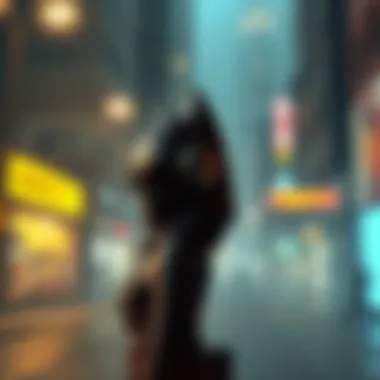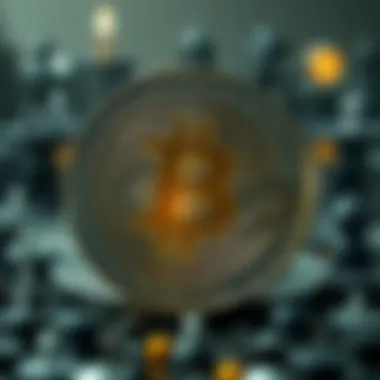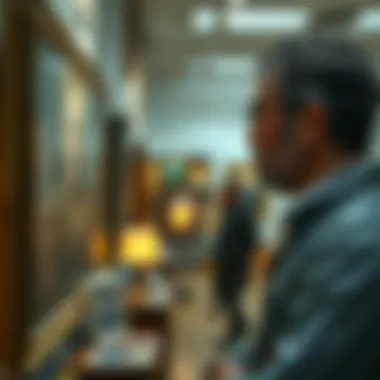Acquiring Banksy NFTs: Insights and Implications


Intro
The merging of street art with the realms of digital innovation has led to new avenues of exploration, particularly through non-fungible tokens, or NFTs. Among the most prominent figures in this space is Banksy, a street artist whose works have transcended traditional boundaries and have now found their way into the digital landscape. This article aims to provide insights into acquiring Banksy NFTs, touching on essential concepts, investment strategies, and the broader implications for collectors and the art market.
As the interest in digital art rises, the understanding of NFTs becomes crucial for both seasoned collectors and crypto enthusiasts. This narrative will delve into the intricate details of what makes Banksy NFTs a significant addition to the world of digital assets and how one can navigate the acquisition process effectively.
The Rise of NFTs in the Art World
The ascent of Non-Fungible Tokens (NFTs) has shifted the paradigm of how art is created, owned, and traded. These digital assets offer a myriad of benefits that are slowly reshaping the traditional art landscape. Unlike fungible assets such as cryptocurrency, which are interchangeable, NFTs represent unique items or content. In the context of art, this uniqueness grants artists unprecedented control over their work and opens avenues for new forms of revenue.
One of the most compelling aspects of NFTs in the art world is their ability to authenticate ownership through blockchain technology. This not only combats forgery but also preserves provenance, thus fostering trust among collectors. For investors and enthusiasts alike, the assurance that a digital artwork is an original piece can elevate its value considerably. Moreover, the immediate resale rights encoded into smart contracts allow artists to receive a cut from future transactions, thus creating a sustainable economic model.
The rise of NFTs has also democratized access to art. With traditional art markets often favoring established players, digital platforms can lower barriers, enabling emerging artists to showcase their creations.
"NFTs could level the playing field for artists, helping diversify who gets recognition."
Furthermore, the environmental and social dimensions of NFTs cannot be ignored. Critics of this growing trend have raised concerns about the carbon footprint associated with blockchain transactions. As discussions about sustainability continue, the art community is tasked with balancing innovation with ethical considerations.
Key Considerations:
- Authenticity & Provenance: NFTs eradicate doubts over authenticity.
- Economic Model: Artists can earn royalties through secondary sales.
- Accessibility: Digital platforms can showcase talent beyond geographical limits.
- Sustainability Concerns: The art community must consider the environmental impacts of NFT transactions.
In summary, the rise of NFTs in the art world presents both exciting possibilities and complex challenges. As artists, collectors, and investors navigate this new terrain, the dialogue surrounding the implications of digital ownership will only intensify.
Banksy: Artistry Meets Digital Ownership
In recent years, the art world has witnessed a dramatic shift fueled by the emergence of digital assets, particularly Non-Fungible Tokens, or NFTs. Within this landscape, Banksy stands out as an icon whose street art has birthed a new frontier in art ownership. The intersection of Banksy’s creativity and the world of digital ownership speaks volumes about how art is perceived and commodified today.
NFTs offer a unique opportunity for both artists and collectors. For artists like Banksy, they represent a way to leverage new technology to challenge traditional ownership structures. The implications of this cannot be overstated; it allows a broader audience to engage with art that was once confined to galleries and private collections. This evolution embodies democratization in the art realm, making significant cultural statements accessible to many.
A Brief Overview of Banksy's Artistic Journey
Banksy’s rise to fame is a tale marinated in urban grit and subversive commentary. Since the late 1990s, he has pushed boundaries with his thought-provoking graffiti that often critiques societal norms. His unique blend of dark humor and striking visuals speaks to the disenfranchised and gives a voice to the voiceless. But why does this matter in the context of NFTs? The answer lies in how his works have transcended the gallery walls, collecting admirers from every nook and cranny of society.
Many regard Banksy as a symbol of rebellion within the art community. His anonymity isn’t just a gimmick—it's part of a broader narrative. The secrecy surrounding his identity and the philosophy behind his art becomes even more compelling as it transitions into the digital realm. As collectors turn towards NFTs, the intrinsic value of Banksy’s message takes root in the digital landscape, giving birth to a new collection avenue.
Banksy's Transition to NFTs
The leap from physical art to the digital sphere is not insignificant. Banksy’s foray into NFTs allows for artistic expression in ways traditional formats can’t offer. Notably, his 2021 piece, Love is in the Bin, famously shredded at auction, subsequently re-emerged as an NFT, challenging the norms of art preservation and ownership. This act alone sparked a flurry of discussions about authenticity and value in the digital age—questions that many collectors are just beginning to grapple with.
Moreover, the use of blockchain technology acts as a seal of authenticity, protecting his work from counterfeiting while still engaging audiences on various platforms. It’s as if Banksy has redefined art for a generation that thrives on ideation and swift exchanges.
How to Buy a Banksy NFT
As the digital art world continues to expand, understanding how to buy a Banksy NFT becomes crucial for both seasoned collectors and newcomers alike. This process involves navigating unique marketplaces, setting up the right digital infrastructure, and deciphering the buying process. Each step may seem daunting but holds significant value in ensuring authenticity, ownership, and the overall investment security of these digital assets.


Choosing the Right Marketplace
The first crucial step is selecting a marketplace where Banksy's NFTs are available. Not all platforms sell the same categories of NFTs, so doing thorough research is essential. Some popular options include OpenSea, Rarible, and SuperRare. These platforms cater to different kinds of buyers and have various features that may appeal to specific user needs.
When considering a marketplace:
- Reputation Matters: Look for platforms with established credibility in the NFT community. Remember, not all marketplaces are created equal, and some have been known to host fraudulent listings.
- Fees and Royalties: Each marketplace has its own fee structure. Make sure to calculate what portion of your investment will go to fees to avoid unpleasant surprises.
- User Experience: A marketplace should be user-friendly, guiding both buyers and sellers through the process clearly.
Choosing the right place can save time and money, but it also sets the tone for the experience of acquiring Banksy’s unique digital works.
Setting Up a Digital Wallet
After picking the right marketplace, the next step is to set up a digital wallet. This is akin to having a bank account but for cryptocurrencies and NFTs. Many wallets today ensure security and ease of use, which is a big win for users.
- Types of Wallets: There are different types of wallets available, including hot wallets (online) and cold wallets (offline). Hot wallets are more user-friendly, allowing for quick transactions, while cold wallets offer enhanced security for long-term storage.
- Compatibility: Ensure that the wallet you choose is compatible with your chosen marketplace. Not all wallets work with every platform.
- Security Features: Look for wallets that offer two-factor authentication and backup options. You wouldn’t leave your house unlocked; treat your wallet with the same caution.
Once your wallet is set up, you’ll be able to buy, store, and transfer your digital assets securely.
The Buying Process
Once you have your wallet funded and a trustworthy marketplace selected, you can dive into the buying process of a Banksy NFT. Here's a step-by-step breakdown:
- Browse Listings: Start by exploring the available Banksy NFTs. Each listing will provide relevant details including price, description, and transaction history.
- Analyze the Asset: Take time to scrutinize the asset's authenticity, previous sales, and the owning rights attached. Given Banksy's celebrity status, you need to be particularly vigilant to avoid scams.
- Make an Offer: If you find a piece you wish to acquire, you can either buy it outright or make an offer if the seller allows. Be sure to adhere to the market rules surrounding bidding and offer periods.
- Finalize the Purchase: Upon acceptance of your offer—or if you purchased outright—follow the marketplace procedures to complete the transaction.
- Transaction Confirmation: After the purchase, ensure that you receive a transaction confirmation in your wallet. This verifies your ownership of the digital art.
By understanding each of these steps, you empower yourself in the NFT space, specifically in acquiring Banksy's digital masterpieces. With the right preparation, investing in these unique art pieces becomes less of a perplexing enigma and more of an engaging journey.
"The world of NFTs is both a wild west and a gallery of the future, where every pixel can hold immense value."
Acquiring a Banksy NFT represents not only a financial investment but also a step into a new cultural phenomenon. As digital assets continue to find their footing, those who enter thoughtfully will be in a more secure position to navigate this rapidly evolving landscape.
Valuation of Banksy NFTs
Understanding the valuation of Banksy NFTs is paramount for anyone delving into this digital art realm. It integrates both art and technology, inviting a diverse audience ranging from collectors to crypto enthusiasts, all seeking to gauge the worth of these virtual assets. Unlike traditional artworks, where valuation is often determined through physical attributes and historical context, the world of NFTs presents unique challenges and opportunities. Various factors come into play, including the artist’s reputation, market demand, and the technological underpinnings, shaping the financial landscape surrounding these digital artifacts.
Factors Influencing NFT Prices
The pricing of Banksy NFTs is influenced by several key elements:
- Artist Reputation: Banksy’s standing as a street artist significantly elevates the potential value of his NFTs. The more sought-after the artist, the more buyers are willing to pay. This is particularly true for Banksy, whose works are often steeped in social commentary and evade traditional definitions of art.
- Scarcity and Exclusivity: The principle of scarcity serves as a substantial driver in the NFT market. Each Banksy NFT is unique or part of a limited series, and this rarity boosts its allure. Collectors are often keen to own a piece that few others possess, which can lead to skyrocketing prices.
- Market Demand: The broader market trends and investor sentiment invariably impact the prices of NFTs. If the digital art space is buzzing with interest, the values may rise accordingly, sometimes erratically. Economic climates, investment trends, and even media exposure can sway public interest.
- Technological Factors: The underlying blockchain technology can affect valuation as well. For instance, NFTs minted on a more recognized blockchain platform like Ethereum might be absorbed into mainstream consciousness more readily. Conversely, alternative blockchains with less visibility can struggle to command the same prices.
- Cultural Relevance: Given Banksy’s work often reflects contemporary social issues, cultural significance can also inform valuation. An NFT representing themes that resonate with current events might garner more interest and thus more value from buyers looking to make a statement through their collection.
Market Trends and Analysis
The valuation of Banksy NFTs is not static; it evolves. Observing market trends is essential to understanding potential future valuations. Here are some factors to consider:
- Increasing Acceptance of Digital Art: As more artists transition to the digital format and embrace NFTs, the general acceptance of these assets is on the rise. This trend increases competition and interest, potentially driving up valuations.
- Fluctuations in Cryptocurrency: Prices of NFTs are often tied to the value of cryptocurrencies. If Bitcoin or Ethereum see significant price hikes, it can result in non-fungible token values spiraling upward as well.
- Emerging Platforms: The launch of new NFT marketplaces and platforms can provide alternative venues for buying and selling Banksy NFTs. This increased accessibility could broaden interest and participation in the market, thereby impacting valuations.
- Collector Behaviors: Understanding collector motivations is crucial. Some may invest solely for profit, while others seek to make connections or demonstrate their appreciation of Banksy’s work. This duality in motivation affects how prices trend over time.


In summary, valuating Banksy NFTs necessitates a comprehensive grasp of various interrelated elements. From market dynamics to individual motivations and artist reputation, every aspect plays a role in crafting the financial narrative of these innovative assets. Keeping an eye on these variables can help investors make more informed decisions, operating effectively in the ever-evolving landscape of digital art investment.
"The evolution of art has always reflected the society from which it arose, and now with NFTs, we’re witnessing another seismic shift."
Understanding and navigating these currents can open up immense opportunities for those interested in acquiring a piece of Banksy in the digital domain. For more detailed and ongoing analysis, you can explore links like wikipedia.com and reddit.com.
Legal Considerations in Acquiring NFTs
Navigating the world of NFTs isn't just about aesthetics or technology; it's crucial to understand the legal landscape that frames these virtual assets. As more individuals dive into buying Banksy NFTs, comprehending legal matters becomes essential. This section investigates two pertinent aspects: copyright and ownership rights, and the emerging regulations shaping the future of NFTs. Understanding these elements can help collectors avoid potential pitfalls and ensure they protect their investments.
Understanding Copyright and Ownership
When diving into the purchase of any NFT, the understanding of copyright and ownership is paramount. Simply put, buying an NFT does not automatically grant the buyer the exclusive rights to the artwork associated with it. In fact, most times, the copyright remains with the original artist. For instance, when you acquire a Banksy NFT, you're purchasing a unique token on the blockchain that proves your ownership of that particular digital asset, but the underlying rights to the artwork might still belong to Banksy himself.
It’s vital for collectors to confirm what exactly they are buying when sealing the deal on any NFT. This could include:
- Usage Rights: Can you display it in an exhibition, use it in merchandise, or create derivative works?
- Transferability: Are you allowed to sell the NFT later?
- Resale Rights: Is there a percentage of future sales that goes back to the original artist?
Clarifying these elements can prevent misunderstandings later on. Collectors may wish to seek detailed clarification from the marketplace or the artist regarding the rights transferred with the purchase.
The fine line between owning an NFT and owning the right to the image it represents is a gray area that needs careful examination.
Future of NFT Regulation
The NFT market is rapidly evolving, and with it, so are the regulatory frameworks that govern it. While the technology itself is groundbreaking, the legal aspects are still catching up. Various governments around the world are grappling with how to regulate digital assets, and that could mean the difference between well-informed investment and costly mistakes for those entering this space.
Discussions around regulations often involve key points like:
- Consumer Protection: How will buyers be protected against fraud or misrepresentation?
- Tax Implications: What are the tax responsibilities when selling or trading NFTs?
- Intellectual Property: How will rights be enforced in the digital arena?
While regulations can be viewed as a hindrance, they also provide a sense of legitimacy and security to the market. Awareness of evolving laws can improve peace of mind for collectors as they navigate their acquisitions. Keeping tabs on the legal changes will be vital; platforms like Wired or legal resources such as Lexology can offer updates and insights relevant to the NFT landscape.
Cultural Implications of Banksy NFTs
The rise of Banksy NFTs offers an intriguing look into how digital innovation is reshaping art and culture. When we consider the cultural implications of these digital assets, we find ourselves at a crossroads of tradition and technology. With NFTs, Banksy’s work transcends physical boundaries, enabling a broader audience to engage with and connect to art in ways previously unimaginable. This section aims to explore how these changes affect perceptions of art, the role of digital creations, and the implications for both artists and collectors.
Changing Perceptions of Art
Traditionally, art has been confined to the gallery walls, a realm accessible mostly to the few. However, when Banksy's art moves into the digital space as NFTs, it challenges this status quo. No longer just a physical item, art becomes a dynamic entity – a living, breathing part of the digital landscape. This has sparked discussions on authenticity and value, essential components to understanding culture today.
The perception shifts from tangible prints and canvases to digital ownership, where collectors buy into the idea of art more than the art itself. Collectors now ask themselves:
- What does it mean to own a piece of digital art?
- Is its value inherently tied to the artist’s reputation?
- How does the notion of exclusivity change in a digital landscape?
As people engage with Banksy's NFTs, they are not just purchasing images; they are tapping into a cultural phenomenon that reflects broader societal changes. The conversation surrounding digital art is not merely about aesthetics or transactions; it’s about identity, ownership, and the evolution of artistic expression.


The Role of Digital Art in Society
In our current era, digital art is not an afterthought or a mere extension of traditional forms. Instead, it serves as a pivotal element in the art ecosystem and beyond. As Banksy embraces this medium, he catalyzes discussions about the role digital art plays in society today.
Digital art can illustrate complex themes such as:
- Social Commentary: Many works, including Banksy's, comment on modern social issues ranging from politics to consumerism. NFTs, by nature, amplify these voices with global reach.
- Access and Inclusivity: Digital platforms democratize access to art, breaking down barriers that have historically existed. Anyone with internet access can interact with the art and the community surrounding it.
- Economic Shifts: Banksy NFTs alter the financial dynamics of art sales, leading to new opportunities for artists to monetize their work outside traditional galleries.
As we witness the rise of institutions like the Museum of Modern Art (MoMA) recognizing digital pieces, one cannot help but ponder the ever-evolving narratives shaped by technology and creativity hand in hand. This revolution is not just creating ripples in the art community but extending to society as a whole, redefining how we view and interact with culture and creativity.
Future Outlook for Banksy NFTs
Understanding the future of Banksy NFTs is not just a matter of looking at where digital art is headed; it’s about grasping the very essence of art ownership in a tech-driven world. The prominence of Banksy, a name etched in the annals of street art, juxtaposed with the burgeoning NFT landscape, creates a unique narrative that invites both skepticism and excitement. The implications of this crossover influence art collectors, investors, and even casual observers.
The significance of Banksy NFTs isn’t confined to their aesthetic value. Instead, it beckons a broader conversation about authenticity, provenance, and the digital representation of art. As more creators embrace NFTs, those investing in Banksy’s digital works are not merely buying an artwork; they are securing a stake in a potential cultural shift. The future lies within the intersection of technology and the human experience, shaping how art is perceived, collected, and valued.
"The future of art lies in the digital realm, where each NFT holds its own story, heritage, and cultural significance."
Predictions for the Digital Art Market
Looking ahead, the digital art market is poised for exponential growth. Analysts predict a surge in demand for NFTs, driven by a blend of changing consumer behaviors and technological advancements. The recent interest in digital collectibles, spurred by various high-profile sales and celebrity endorsements, indicates a robust potential for price appreciation.
Key trends that might shape this outlook include:
- Increased Acceptance: More traditional art institutions are beginning to recognize NFTs, lending them legitimacy and attracting a wider audience.
- Enhanced User Experience: Innovations in virtual reality and augmented reality may redefine how audiences interact with art, making NFTs even more appealing.
- Diverse Formats: Emerging artists are pushing the boundaries, creating varied forms of digital art that appeal to different tastes and preferences.
As these elements converge, they reinforce the idea that investing in Banksy NFTs is as much about acquiring cultural capital as it is about monetary gain.
Integrating Technology with Artistic Expression
The synergy of technology and art is not a new phenomenon, but with Banksy's NFT involvement, it takes on a heightened significance. Artists now have tools at their fingertips that were previously unimaginable. From blockchain verification to decentralized marketplaces, technology reshapes how art is created, shared, and cherished.
One of the most compelling aspects is how artists can now engage with their audiences directly. No longer at the mercy of galleries and auction houses, they can maintain creative control and ensure fair compensation. This opens the door for artists to:
- Experiment Freely: The digital domain allows for greater experimentation without the risk associated with physical mediums.
- Build Communities: Social media and online platforms enable direct interaction with fans and collectors, fostering community around their work.
- Control Distribution: Smart contracts make it easier to dictate how their art is sold and resold, ensuring a more equitable financial landscape.
In the case of Banksy, this integration of technology provides an avenue for the culmination of street art's rebel ethos with the contemporary digital marketplace. As more artists follow suit, the future of art—and specifically that of Banksy NFTs—looks to remain dynamic and thought-provoking well into the foreseeable future.
Ending
As we draw our exploration of Banksy NFTs to a close, it's essential to reflect on the significance of this convergence between art and technology. The insights discussed throughout this article have primed us for understanding not only the buying process but also the broader implications that these digital assets carry within the contemporary art sphere.
The Importance of Ending in This Article
Beneath the surface of our discussion lies a continuous evolution that art, particularly street art, undergoes as it transitions to the digital realm. One needs to recognize that acquiring a Banksy NFT is not simply about ownership. It's about stepping into a new realm where traditional aesthetic remains intertwined with cutting-edge technology, thus reshaping our engagement and experience with art.
From an investment standpoint, Banksy NFTs are a fascinating case study. The diversity in valuation, bolstered by the unique nature of their blockchain signatures, presents both challenges and opportunities. Investors should be cognizant of market trends, legal implications, and cultural shifts as they navigate this landscape.
Moreover, the focus on digital ownership raises thought-provoking questions around authenticity and accessibility. As the art world becomes increasingly globalized and digitized, the implications extend far beyond the transaction. They touch on deeper topics such as the democratization of art and the challenges associated with its preservation.
In summary, while we may conclude our specific discussion on Banksy NFTs, it marks merely the beginning of what promises to be an exciting journey for artists, collectors, and technology enthusiasts alike. As we stand on this brink of transformation, it becomes crucial that we remain informed and engaged in ongoing dialogues surrounding this digital era. It’s a momentous time to be involved in the art market, as each of us plays a part in shaping the future of digital artistry.
"Art is the most beautiful of all lies; that's why the truth in it must be preserved." - Unknown







